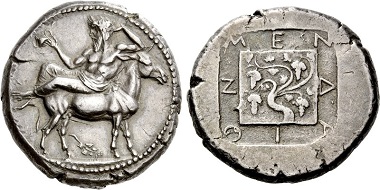by Alan Walker
April 5, 2018 – Do you have to do with ancient coins? Did you ever ask yourself where they are coming from? Alan Walker of Zurich Nomos AG will presents a comprehensive overview of this crucial subject. The second part presents three different kinds of deposits.
If you want to start with the first part about hoards, click here.
2) Deposits
The crucial difference between hoards and deposits is that deposits were not meant to be recovered, while hoards were. Perhaps if we termed them votive deposits it would make things clearer: the coins or other precious material they contain were meant as gifts to the gods and, as such, belonged to them and were no longer for human use. Here are some examples.
a) Foundation Deposits
In ancient times, as today, special objects are buried in the corner stones of important new buildings; in many cases these include coins and medals. In the 15th century Sigismondo Malatesta, lord of Rimini, had a variety of medals made, all bearing either his portrait or that of his wife, Isotta degli Atti, which were placed in the foundations of the buildings he erected. In Persepolis, there is the famous Apadana Deposit, which included coins as symbols of the extent of the Persian Empire.
Nomos 5, 2011, 135. Mende, from the Kaliandra Hoard of 1913 (IGCH 358). Est. 20,000 / Hammer 40,000 CHF.
b) Water Deposits
Precious items, including coins, were often thrown into rivers, springs and wells as offerings to the gods. Unlike at the modern Fontana di Trevi in Rome (“Three Coins in a Fountain”), into which every visitor tosses coins in a vow to return, and where employees sweep up all the coins every day for charity, coins thrown into sacred springs in ancient times often remained there until their modern discovery. A number of such ‘spring hoards’ or ‘spring deposits’ have been found. All sorts of items have been dredged from rivers as well, many of which were certainly originally thrown in as votives to the gods.
c) Land Deposits
Recently, in England, a metal detectorist discovered a hoard of Roman coins, which he instantly reported so that it could be excavated properly by an archaeological team. The excavation was carried out with great care and it was initially assumed that what was found was a savings hoard. The many thousands of coins involved were contained within a pottery jar, and it was clear that different groups of coins were poured into the jar at different times. However, what struck the excavators as particularly strange was the fact that the large jar itself was both thin and very weak; they believed that once set in the ground that jar could never have been removed since it would, in their opinion, undoubtedly have shattered. The site itself showed signs of being some sort of rural field sanctuary, so the excavators became convinced that the deposit was meant to be a permanent one.
The third part of this series is dedicated to losses.
We are sure that everybody knows who Alan Walker is, nevertheless, for those who don’t or who have forgotten, here’s the link to our numismatic Who’s who.
You can find the contact details of Alan Walker on the Nomos website.
More articles on treasure finds are available in our respective archive section.




